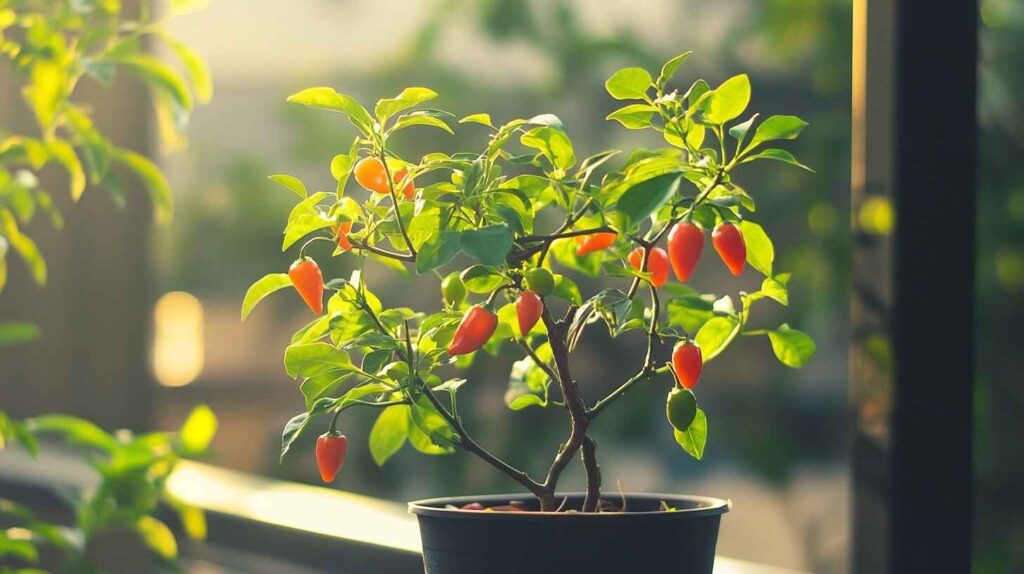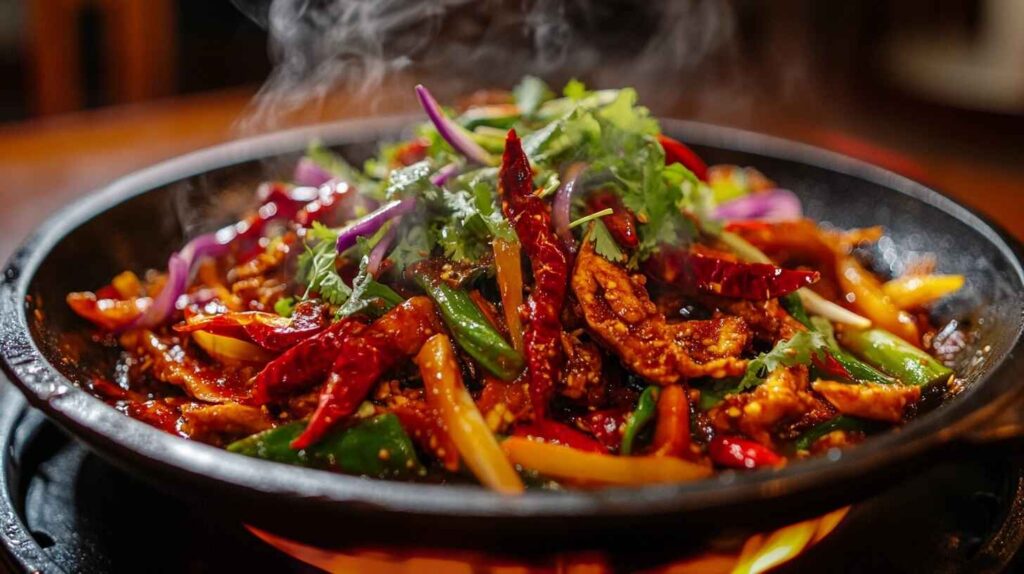Thai chili, also known as prik kee noo (which translates to “mouse dropping chili” due to its small size), is a fiery little pepper that packs a serious punch. Used in traditional Thai cuisine, it has gained global popularity thanks to its intense heat and distinctive flavor. Whether you’re a spice lover, a home cook, or a gardener looking to grow your own chili plants, this guide will provide everything you need to know about Thai chili.
Table of Contents
Thai chili isn’t just about heat—it’s about elevating flavors, boosting health, and even creating a stunning garden plant.
What is Thai Chili? A Fiery Introduction
The Origin and History of Thai Chili
Thai chili originated from South America but was introduced to Thailand and other parts of Asia by Portuguese traders in the 16th century. Over time, it became an essential ingredient in Thai cooking, adding depth, spice, and complexity to traditional dishes.
Popular Varieties of Thai Chili
There isn’t just one type of Thai chili! Several varieties are commonly used in cooking, each with its own flavor profile and heat level:
- Prik Kee Noo (Bird’s Eye Chili) – Tiny but incredibly spicy, often used in stir-fries and dipping sauces.
- Prik Chee Fah (Sky-Pointing Chili) – Milder than Bird’s Eye, commonly used in curries and salads.
- Prik Jinda – Medium-sized and medium-hot, a great all-purpose Thai chili.
How Spicy is Thai Chili? (Scoville Heat Scale)
The heat level of Thai chili ranges from 50,000 to 100,000 Scoville Heat Units (SHU), making it significantly hotter than jalapeños but milder than habaneros. If you’re not used to spicy food, handle Thai chili with care!
Culinary Uses of Thai Chili in Traditional and Modern Dishes
Thai Chili in Thai Cuisine: Key Dishes
Thai chili is the heart of many Thai dishes, adding that signature heat and depth. Some of the most famous recipes featuring Thai chili include:
- Tom Yum Soup – A hot and sour soup with shrimp, lemongrass, and Thai chili.
- Pad Kra Pao – Spicy basil stir-fry, often made with chicken or pork.
- Som Tam – A refreshing and spicy green papaya salad.
- Nam Prik – Traditional Thai chili paste served with vegetables and rice.
How to Use Thai Chili in Different Cuisines
While Thai chili is a staple in Thai cooking, it also works wonders in other cuisines:
- Mexican Cuisine – Adds a punch to salsas and tacos.
- Indian Cuisine – Enhances the spice level in curries.
- Chinese Cuisine – Brings heat to Sichuan-style stir-fries.
Fresh vs. Dried vs. Pickled Thai Chili: What’s the Difference?
Thai chili can be used in various forms:
| Type | Best Uses |
|---|---|
| Fresh Thai Chili | Best for stir-fries, soups, and fresh salsas. |
| Dried Thai Chili | Ideal for grinding into chili powder or using in chili oil. |
| Pickled Thai Chili | Commonly used as a spicy condiment for noodles and rice dishes. |
Thai Chili-Based Sauces and Condiments
Thai chili is a key ingredient in many popular sauces, such as:
- Sriracha Sauce – A famous chili sauce with a garlicky kick.
- Nam Jim – A sweet, spicy, and tangy Thai dipping sauce.
- Chili Oil – A staple in Asian cuisine for drizzling over noodles.
Health Benefits of Thai Chili
Thai Chili and Metabolism Boosting
Capsaicin, the compound responsible for Thai chili’s heat, is known to boost metabolism and aid in weight loss. It increases thermogenesis, helping the body burn more calories.
Anti-Inflammatory and Pain-Relief Properties
Despite its fiery nature, Thai chili can actually reduce inflammation. Capsaicin has been used in pain relief treatments for conditions like arthritis and muscle pain.
Heart Health and Immune System Support
Eating spicy foods like Thai chili may lower cholesterol, improve blood circulation, and strengthen the immune system due to its high vitamin C content.
Side Effects and Precautions of Eating Thai Chili
While Thai chili offers many benefits, overconsumption can lead to:
- Digestive discomfort, including heartburn.
- Skin irritation if handled improperly.
- Burning sensation if it comes into contact with sensitive areas.
Thai Chili Recipe: Spicy Thai Chili Sauce
Ingredients
| Ingredient | Quantity |
|---|---|
| Fresh Thai Chilies | 10-12 (adjust to taste) |
| Garlic Cloves | 4 cloves |
| Rice Vinegar | 1/4 cup |
| Fish Sauce | 1 tablespoon |
| Sugar | 1 teaspoon |
| Salt | 1/2 teaspoon |
Directions
- Remove the stems from the Thai chilies.
- Blend all the ingredients together until smooth.
- Adjust seasoning to taste.
- Store in an airtight container and refrigerate for up to two weeks.
Final Thoughts
Thai chili is more than just a fiery spice—it’s a culinary gem, a health booster, and even a rewarding plant to grow. Whether you’re cooking up a storm, exploring its health benefits, or trying to cultivate your own, there’s always something exciting about this tiny but mighty pepper.
Embrace the heat, savor the flavors, and let Thai chili take your cooking to the next level!
How to Grow Thai Chili at Home: A Complete Guide

Ever thought about growing your own Thai chili plant? Whether you’re an experienced gardener or just getting started, cultivating Thai chili at home can be a rewarding experience. These compact plants are perfect for pots, balcony gardens, or backyard plots. Plus, there’s nothing quite like harvesting your own spicy chilies to use in homemade recipes!
“Growing Thai chili is easier than you think—just give it the right amount of warmth, light, and care, and you’ll be rewarded with an abundance of spicy peppers!”
Best Climate and Soil Conditions for Thai Chili
Thai chili thrives in warm, humid environments with plenty of sunlight. Here’s what you need to ensure your chili plants grow strong and produce plenty of fruit:
- Temperature: Ideal between 75-85°F (24-29°C). Thai chili is highly sensitive to frost, so avoid planting in cold seasons.
- Sunlight: Requires at least 6-8 hours of direct sunlight daily.
- Soil: Well-draining, nutrient-rich soil with a pH between 5.5 and 7.0.
- Watering: Regular but moderate watering—keep the soil moist but not waterlogged.
Step-by-Step Growing Process: From Seed to Harvest
- Start with Seeds: Plant Thai chili seeds in small pots or seed trays filled with potting soil.
- Provide Warmth: Keep the seeds in a warm location (above 75°F) and maintain moisture until germination, which typically takes 7-14 days.
- Transplanting: Once the seedlings develop a few leaves, transplant them into larger pots or garden beds.
- Support Growth: Use a light organic fertilizer every few weeks to promote healthy growth.
- Pruning: Trim excess leaves to encourage better air circulation and fruit production.
- Harvesting: Pick Thai chilies when they turn bright red (for maximum heat) or green (for milder spice). Harvesting regularly encourages the plant to produce more chilies.
Common Thai Chili Plant Problems and Solutions
Like any plant, Thai chili faces some challenges. Here’s how to troubleshoot common issues:
| Problem | Cause | Solution |
|---|---|---|
| Leaves Turning Yellow | Overwatering or nutrient deficiency | Reduce watering; add organic fertilizer. |
| Wilting or Drooping | Underwatering or excessive heat | Water consistently; provide afternoon shade in hot climates. |
| Pests (Aphids, Spider Mites) | Insects feeding on leaves | Use neem oil spray or insecticidal soap. |
| Fungus or Mold | Poor air circulation, excessive humidity | Space plants properly; avoid watering leaves. |
How to Harvest and Store Thai Chili
Once your Thai chilies are ready for harvest, you have several options for storage:
- Fresh Storage: Keep chilies in the refrigerator for up to two weeks.
- Dried Thai Chili: Hang them in a dry, airy space or use a dehydrator.
- Pickled Thai Chili: Store in vinegar and salt to preserve their heat and flavor.
Common Problems with Thai Chili (Cooking & Gardening)

Why Does Thai Chili Taste Bitter?
Sometimes Thai chili may have a bitter taste instead of its usual fiery spice. This could be due to:
- Harvesting the chilies too early.
- Overexposure to direct sunlight without adequate watering.
- Using the seeds, which can be more bitter than the flesh.
How to Reduce Thai Chili Heat in Cooking?
If your dish turns out too spicy, don’t panic! Here are a few ways to balance the heat:
- Add coconut milk, yogurt, or cream to neutralize the spice.
- Increase the amount of sugar, lime juice, or vinegar for balance.
- Remove the seeds before cooking—most of the heat is concentrated there.
Common Pests and Diseases Affecting Thai Chili Plants
Aside from pests like aphids and mites, fungal diseases can also affect Thai chili plants. The best prevention method is ensuring proper air circulation and not overwatering the soil.
Fun Facts and Myths About Thai Chili
Thai chili has been around for centuries and has some interesting cultural significance. Let’s explore some fun facts!
Why Thai Chili is Considered a “Superfood”
Due to its high levels of antioxidants, vitamin C, and metabolism-boosting capsaicin, Thai chili is often labeled a “superfood.” Regular consumption in moderate amounts can contribute to a healthier diet.
Thai Chili in Folklore and Traditional Medicine
In some cultures, Thai chili is believed to ward off bad spirits. In Thai traditional medicine, it has been used to treat colds, improve circulation, and even aid digestion.
Where to Buy Thai Chili (Fresh, Dried, and Seeds)
Best Local Markets and Online Stores for Thai Chili
If you can’t grow your own Thai chili, don’t worry—you can find them in Asian grocery stores or online retailers. Look for:
- Fresh Thai chilies at farmers’ markets or Asian supermarkets.
- Dried Thai chili in spice aisles or online spice shops.
- Thai chili seeds from gardening stores or specialty seed suppliers.
FAQs
1. How spicy is Thai chili compared to other peppers?
Thai chili ranges between 50,000 to 100,000 Scoville Heat Units (SHU). This makes it 10-20 times hotter than jalapeños (2,500–8,000 SHU) but milder than habaneros (100,000–350,000 SHU).
2. What’s the difference between Thai Bird’s Eye Chili and Thai Jinda Chili?
Bird’s Eye Chili (Prik Kee Noo) – Tiny, extremely spicy, often used in stir-fries and sauces.
Jinda Chili (Prik Jinda) – Slightly larger, moderately spicy, commonly used in curries and Thai soups.
3. Can I reduce the heat of Thai chili in my dishes?
Yes! To tone down the heat:
Remove the seeds and inner membrane before cooking.
Mix with coconut milk, yogurt, or sugar to balance the spice.
Use fewer chilies or opt for milder Thai chili varieties like Prik Chee Fah.
4. How can I use Thai chili in cooking?
Thai chili enhances flavor in:
Soups & Broths: Tom Yum, Tom Kha
Stir-Fries: Pad Kra Pao (Thai Basil Chicken)
Sauces & Pastes: Nam Prik Pao (Thai Chili Paste), Sriracha
Salads & Dips: Som Tam (Papaya Salad), Thai dipping sauces
5. Can I grow Thai chili at home?
Absolutely! Thai chili is easy to grow in pots, gardens, or balconies with the right conditions:
Sunlight: At least 6-8 hours daily
Soil: Well-draining, nutrient-rich
Watering: Moderate, avoid overwatering
Temperature: Best in warm climates (75-85°F / 24-29°C)
6. How long does it take to grow Thai chili from seed?
Thai chili seeds take 7-14 days to germinate and 60-90 days to produce ripe chilies. Regular harvesting encourages more fruit production.
Conclusion: Spice Up Your Life with Thai Chili!
Thai chili is more than just a spice—it’s a culinary powerhouse, a health-boosting ingredient, and a rewarding plant to grow. Whether you’re cooking, gardening, or exploring its health benefits, incorporating Thai chili into your life is sure to bring excitement and heat to your experience.
“Whether you’re chasing flavor, health benefits, or the joy of home gardening, Thai chili is the perfect spice to add to your lifestyle.”

Everything You Need To Know About Thai Chili – A Spicy Guide
- Total Time: 13 minutes
- Yield: 1 cup (approx.) 1x
- Diet: Gluten Free
Description
This homemade Spicy Thai Chili Sauce is a flavorful combination of heat, tanginess, and a touch of sweetness. Made with fresh Thai chilies, garlic, and rice vinegar, it’s perfect for dipping, stir-fries, and marinades. Whether you love it extra spicy or mildly hot, this sauce is a must-have for Thai food lovers!
Ingredients
Main Ingredients:
- 10–12 fresh Thai chilies (adjust to taste) 🌶️
- 4 cloves garlic, minced
- 2 tablespoons shallots, finely chopped
- 1 tablespoon vegetable oil
- 2 tablespoons fish sauce (or soy sauce for vegan option)
- 1 tablespoon tamarind paste
- 1 tablespoon palm sugar (or brown sugar)
- 1 teaspoon salt
- 1 tablespoon rice vinegar
- 2 tablespoons water (as needed for consistency)
Optional Additions:
- 1 teaspoon shrimp paste (for authentic Thai flavor)
- ½ teaspoon lime juice (for extra tang)
Instructions
- Prepare the Thai Chilies: Remove stems and roughly chop the chilies.
- Toast the Ingredients: In a dry pan over medium heat, toast the chilies, garlic, and shallots until fragrant. Set aside.
- Blend the Mixture: In a food processor, blend the toasted ingredients with fish sauce, tamarind paste, sugar, salt, and vinegar until smooth. Add water gradually if needed.
- Cook the Sauce: Heat oil in a pan, pour in the blended mixture, and simmer for 5-7 minutes until thickened. Stir frequently to prevent burning.
- Adjust and Store: Taste and adjust seasoning. Let cool and store in a jar. Refrigerate for up to 2 weeks.
Notes
- For Less Heat: Remove chili seeds before blending.
- For Extra Depth: Let the sauce rest overnight before using.
- Storage Tip: Keeps well in an airtight jar for up to 2 weeks in the fridge.
- Prep Time: 10 minutes
- Cook Time: 3 minutes (optional)
- Category: Sauces & Condiments
- Method: Blending & Simmering
- Cuisine: Thai
Nutrition
- Serving Size: 1 tbsp
- Calories: 12 kcal
- Sugar: 1g
- Sodium: 220mg
- Fat: 0.2g
- Saturated Fat: 0g
- Unsaturated Fat: 0.1g
- Trans Fat: 0g
- Carbohydrates: 2g
- Fiber: 0.3g
- Protein: 0.3g
- Cholesterol: 0mg







